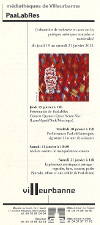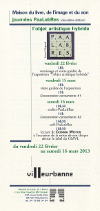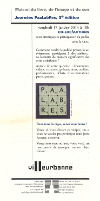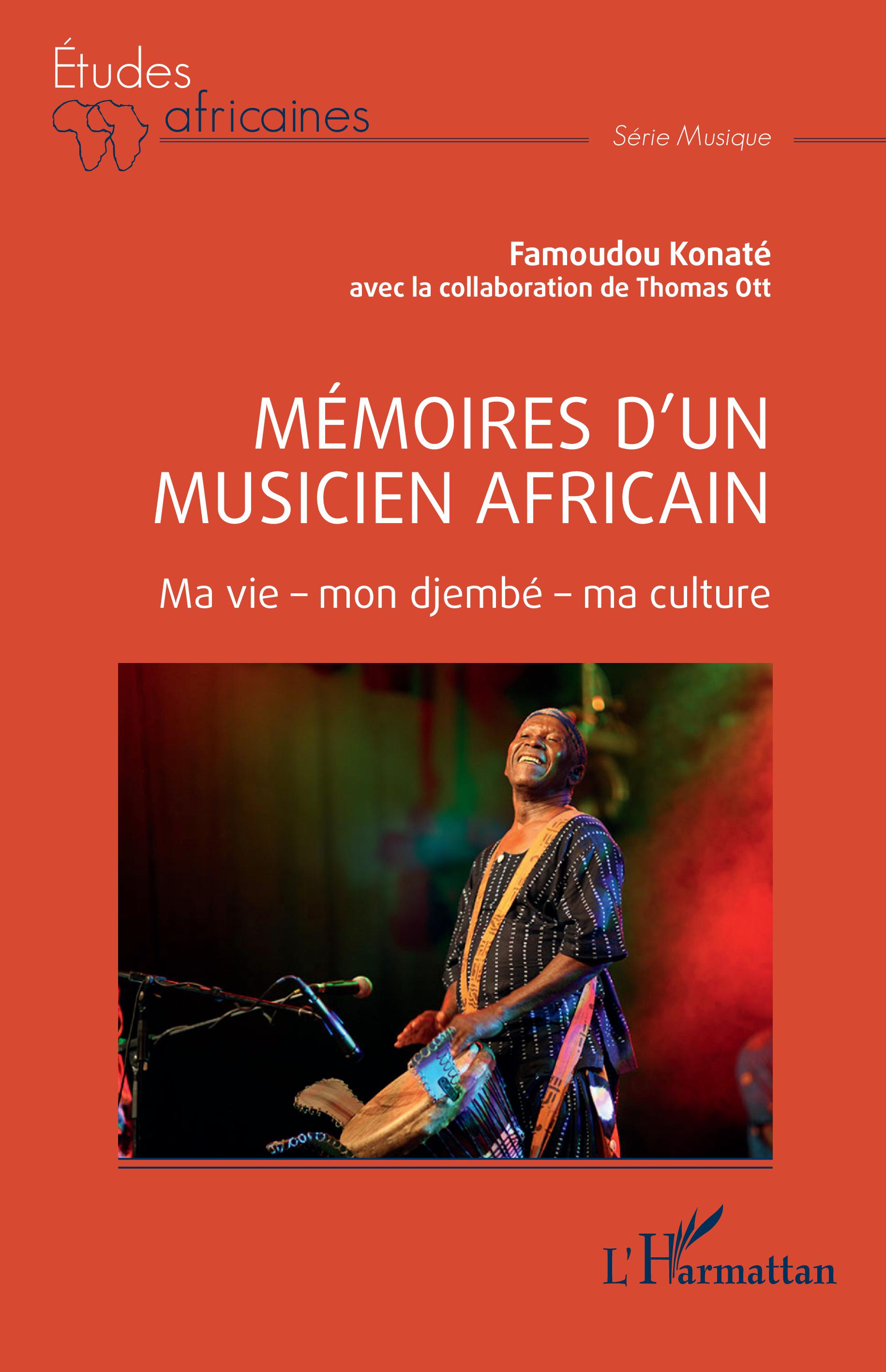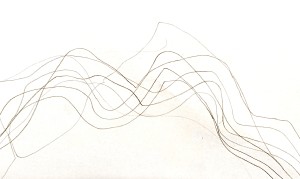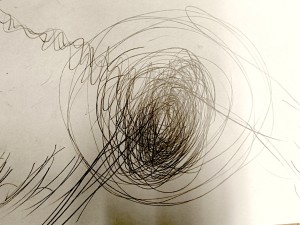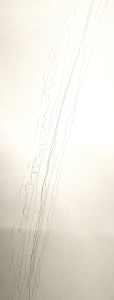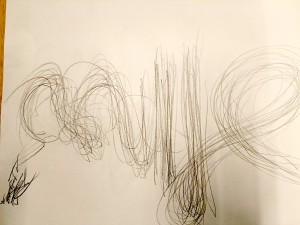Academic year 2010-11
April 2011
May 2011
En acte: Concert of the improvisation trio PFL Traject (Pascal Pariaud, Jean-Charles François, Gilles Laval) at the
Souffle Continu in Paris.
Academic year 2011-12
September 2011 – April 2012
En acte: Improvisation worshops by PFL Traject (Pascal Pariaud, Jean-Charles François, Gilles Laval) at the
Lyon CFMI (Centre de Formation des Musiciens Intervenants à l’école).
January – May 2012
En acte: Residency of the improvisation trio PFL Traject at the André Malraux Center in Vandœuvre-Lès-Nancy. Improvisation workshops with the Nancy Conservatorium (music and dance), the Vandœuvre-Lès-Nancy music school and the Maison des Arts of Lingolsheim in Alsace.
Concerts as part of the Festival Musique Action (May 16, 2012) and in Lingolsheim (May 18, 2012).
January 19-21, 2012
|
Thursday January 19
Friday January 20
PaaLabRantesques Performances, signature of a birth certificat.
Saturday January 21, morning
Workshops open to all of sound manipulations (“Sound shed” by Agnès Moyencourt, “Movicscore” by Nicolas Sidoroff)
Saturday afternoon
Artistic experiences to share: looking, making, listening, speaking (PaaLabRes cell, Spirojki, #flam) |
|
March 19, 2012
En acte:PaaLabRes seminar on the translation (by Jean-Charles François) of “The Embodied Mind”, by
David Borgo (the third chapter of his book,
Sync or Swarn).
27 avril 2012
En acte : PaaLabRes seminar on notation and representation.
Academic year 2012-13
October 2012 – June 2013
En acte: Monthly meetings of the PaalabRes group experimenting with improvisation protocols (Jean-Charles François, Laurent Grappe, Karine Hahn, Gilles Laval, Pascal Pariaud, Gérald Venturi).
October 1, 2012
November 10, 2012
En acte: PaaLabRes seminar with
Clément Canonne on his research on
Collective Free Improvisation.
February 22 – March 16, 2013
En acte: PaaLabRes Days at the
MLIS Villeurbanne,
2nd edition
(Maison du Livre, de l’Image et du Son).
Exhibition “The Hybrid Artistic Object”: opening reception and several guided visits during the month preceding the two PaaLabRes Days.
|
Friday, March 15
“Concertation Concertante #1”, with “Live Pipes” by Pascal Pariaud and Guillaume Dussably; “Documented/tary Harp”, installation and performance by Karine Hahn; “A Musician is Meant to Play”, gestural lecture by Samuel Chagnard; “May 6, 2010, Midnight” a film on Otomo Yoshihide by Sam Harfouche and Marc Siffert; “Its Number is Rose”, performance by Carole Rieussec and Enna Chaton; “Italian Texts”, by Guigou Chenevier, Cyril Darmedru, and Nico Geny.
Saturday May 16, morning
Workshops open to all (“Sound Poetry”, by Jean-Charles François, “Gesture, Music and Everyday Scores” by Pascal Pariaud, “Manipulations of Visual and Sound Objects, Modeling Clay”, by Nicolas Sidoroff.
Saturday afternoon
“Concertation Concertante N#2” with “C9H13NO3 based on Hugues Reip’s Adrénaline, I, II and III, performance by Laurent Fléchier, Agnès Moyencourt, Nicolas Sidoroff, and Gérald Venturi; “GPFL Interconnect”, demonstration-improvisation by Laurent Grappe and PFL Traject (Pascale Pariaud, Jean-Charles François, and Gilles Laval); “Oh fil des ondes” (Oh waves thread) interactive intervention with the audience by Lucio Reco; “Listening Experiences” with the places, acoustics and sound environments” MORGE by Mathias Forge. Saturday late afternoon
Café-PaaLabRes with “What is the Purpose of Musical Theatre?” lecture-performance by Jean-Charles François; “Fred Frith’s Graphic Scores” by the students from Villeurbanne National Music School; discussion with the audience.
Saturday night
Sound poetry with Cosima Weiter for her album release of Ici on the label GMVL. |
|
Mars 2013
En acte: PaaLabRes publication, “Pratiques Artistiques en Actes, LABoratoire de REchercheS, Sur les pratiques nomades et transversales”, in
Revue&Corrigée (written surface of experimental sound practices)
n°95, March 2013, pp.20-24 (carte blanche 1/4).
May 10, 2013
June 2013
En acte: PaaLabRes publication, “Deuxième edition des journées à la Maison du Livre de l’Image et du Son, 15-16 Mars 2013”, in
Revue&Corrigée n°96, June 2013, pp.26-32. (carte blanche 2/4).
July 2013
En acte: Deep Listening Conference, Troy (USA), participation by Jean-Charles François presenting “Improvisation Workshops in Eastern France, 2012”.
Academic year 2013-14
September 2013
En acte: PaaLabRes publication, “Second edition of the Days II” on the hybrid artistic object, content of the various presentations, workshops and debates”, in
Revue&Corrigée n°97, September 2013, pp. 20-28 (carte blanche 3/4).
September 2013 – June 2014
En acte: Projet « MooM (Olivier Messiaen
non-rétrogradable, or Multiple-orchestre-olivier-Messiaen), led by Gilles Laval and Nicolas Sidoroff with Pham Trong Hieu and Franck Testut, at the National Music School of Villeurbanne. This can be found as one of the
itineraries-songs of the paalabres.org first edition
December 2013
En acte: Publication by Nicolas Sidoroff and Gérald Venturi, “PaaLabRes: Concerning
Adrénaline, March 16 2013”, in
Revue&Corrigée n°98, décembre 2013, pp. 14-19 (carte blanche 4/4).
January 17, 2014
En acte: PaaLabRes Days at MLIS Villeurbanne, 3rd edition
(Maison du Livre, de l’Image et du Son).
Co-Loc/actions, artistic acts and audience participation, with GRAC (Groupe Recherche-Action).
Various PaaLabRes workshops and other Ethnogra(c)phies: “catalogue of ‘ethical pieces’” led by Laetitia Overney, Amandine Guilbert and Rémi Eliçabe; “Come to speak to my harp in order to play it” by Karine Hahn; “Addict a phone” led by Gilles Laval and Laurent Grappe; “Let’s Draw Sounds!” led by Nicolas Sidoroff and Gérald Venturi.
A gestural publication, “Bonsoir Clermont!” by Samuel Chagnard; and an accompanied video “Heterogeneous Encounters, Sound Co-constructions” by PFL Traject (Pascal Pariaud, Jean-Charles François, Gilles Laval). |
|
February 16, 2014
En acte: Constitutive General Assembly of PaalabRes organization:
“Purpose: to create a research laboratory on nomadic and transversal practices; to compile a documentation, write and publish in various media, translate and work at the national and French-speaking level in collaboration with European and international partners, to confront a diversity of practices, organize cultural events, encounters, seminars, lectures, conferences, etc.”
February 27 – April 10, 2014
En acte: Sound workshops “Sound Tag”, MLIS Fête du Livre Jeunesse 2014 (Festival of Books for Young People 2014).
Sessions led by Laurent Grappe and Nicolas Sidoroff (February 27, March 21 and 28, April 4), presentation as part of the Fête du livre (on April 10, 2014), with a fifth-grade class from the Émile Zola primary school in Villeurbanne.
Academic year 2014-15
November 20-22, 2014
En acte: Presentation at the JFREM 2014 (Journées Francophones de Recherche en Éducation Musicale) at Cefedem AuRA :
- Samuel Chagnard: “The conditions for blissfull music-making in the conservatorium: what ‘making music’ means”, see the article in pdf format.
- Jean-Charles François, Pascal Pariaud, Gilles Laval (PFL)“Encounters, co-construction of sounds, and collective elaboration of the public presentation: Musique Action 2012 project”, see the article in pdf format.
- Philippe Genet, Pascal Pariaud, Gérald Venturi: “The school through the orchestra – experience in Villeurbanne”.
- Nicolas Sidoroff: “Two examples of musical practices through the lens of popular education”, see the article in pdf format.
February – March, 2015
En acte: Tour of the USA by the improvisation trio PFL Traject (Pascal Pariaud, Jean-Charles François, Gilles Laval): concerts and workshops at the Columbia University, New York, the Manhattan School of Music, New York, New York University, at the Firehouse, Brooklyn, at the University of California San Diego, University of California Santa Barbara, Mills College, Oakland, the Center for New Music, San Francisco and Standford University, Palo Alto.
Summer 2015
En acte: Publication of “Improvisation, Orality, and Writing Revisited” by Jean-Charles François, in
Perspectives of New Music, vol. 53 n°2, pp. 67-144.
Publication of the French version of the same article in the paalabres.org site (Edition 2016, station
“Timbre”).
July 2015
En acte: Concert of the improvisation trio PFL Traject at the Exploratorium Berlin.
Academic year 2015-16
August 18, 2015
En acte: PaaLabRes Encounter with the choreograph Maguy Marin.
February 13-14, 2016
En acte: First weekend of dance-music encounter at
Ramdam, Ste Foy-Lès-Lyon. This is an artistic research project aimed at developing common practical tools bringing music and dance together. A certain number of dancers are associated to Ramdam, notably the Compagnie Maguy Marin; the musicians are part of the wider PaaLabRes collective.
May 2016
En acte: Publication of the
First edition of the paalabres-org website, “Plan PaaLabRes”.
May 2016
En acte: Publication of “Introducing the Collective PaaLabRes in Lyon/France” by Jean-Charles François in
Improfil, Theorie und Praxis improvisierter Musik N°79, Berlin, pp.62-64.
May 7-8, 2016
En acte: Second weekend of the dance-music encounters at Ramdam.
Academic year 2016-17
August 2016
En acte: Participation of Gilles Laval (on stage) and Nicolas Sidoroff (associate researcher) to the creation of the performance
Passion(s) choreography by Maguy Marin,based on Johann Sebastian Bach’s
Saint Matthews Passion.
September 2016 – July 2017
En acte: Project
“100 guitars on a drunken boat”, creation by Gilles Laval, inspired by the ocean and Arthur Rimbaud, for 100 electric guitars spread across a large square (co-production Chef Menteur, Ateliers Frappaz, The National Music School of Villeurbanne). The website as resource to the participants was designed by Nicolas Sidoroff and is hosted on PaaLabRes website.
September 9, 2016
October 6 2016
En acte: Encounter at the Periscope (Lyon), at the initiative of Alexandre Pierrepon, between
The Bridge #4 (Julien Desprez, Rob Mazurek) and PaaLabRes (Jean-Charles François, Gilles Laval, Nicolas Sidoroff).
Publication of this encounter on March 20, 2017 on paalabres.org (Edition 2016, station
“The Bridge”).
November 26-27, 2016
En acte: Third weekend of the dance-music encounters at Ramdam.
January 17, 2017
En acte: Lecture-presentation by Jean-Charles François of the
paalabres.org website at the University of California Irvine, followed by an improvisation workshop with students and faculty.
February 4-5, 2017
En acte: Fourth weekend of the dance-music encounters at Ramdam. Invited guests: Christian Lhopital, visual artist, and Joe Tornabene, musician.
March 24, 2017
En acte: Nicolas Sidoroff, invited by
Marie Preston (visual artist) to describe the interactions during a short moment of collective creation of a music piece by 5 people. Broadcasting in
the # 7 session of the radio show “Radius” [4’15”-25’25”] by Christian Nyampeta as part of the exhibition
“Vocales” (February-April 2017 at the CAC in Bretigny).
March 25-26, 2017
En acte: Fifth weekend of the dance-music encounters at Ramdam. Invited guests: Anan Atoyama, dancer, and David Mambouch, actor, musican and dancer.
June 26, 2017
En acte: Encounter with
Rob Mazurek, musician and visual artist.
Academic year 2017-18
August 5-6, 2017
En acte: encounters organized by Barre Phillips at Puget-Ville (Var), with improvisers from Germany, Italy and France. Participation of Jean-Charles François and presentation of the website
paalabres.org.
September 14-16, 2017
En acte: Paper presentation of “Protocols and schemes of action in collective invention in improvisation” by Jean-Charles François at the
Tracking the Creative Process conference, University of Huddersfield (England).
October 13, 2017
En acte: First day of the seminar-workshop organized in Paris by the “sound art and experimental music research group”
l’Autre Musique (Institut ACTE – UMR 8218 – Paris 1 Panthéon Sorbonne University – CNRS – Ministry of Culture)): “Observe, Preserve” (Jean-Charles François attending).
November 16, 2017
En acte: Concert with
Rob Mazurek as part of his exhibition of serigraphs
“Constellation Scores” at
URDLA, Villeurbanne (with Anan Atoyama, Samuel Chagnard, Jean-Charles François, Gilles Laval, Pascal Pariaud, Nicolas Sidoroff, and Gérald Venturi).
November 20-22, 2017
November 2017
November 30, 2017
En acte: Meetings of the dance-music encounter group to review the 5 weekends at Ramdam.
December 21, 2017
En acte: Second day of the seminar-workshop organized by
L’Autre Musique (Paris 1 Panthéon Sorbonne University), “Form, Transform” at the Cube, Centre de création numérique, Issy-les-Moulineaux (Nicolas Sidoroff attending).
January 17, 2018
En acte: Second meeting of the dance-music encounter group to review the 5 weekends at Ramdam.
February 7, 2018
En acte: Meeting of the dance-music encounter group to watch videos of the 5 weekends at Ramdam.
March 6, 2018
En acte: Second meeting of the dance-music encounter group to watch videos of the 5 weekends at Ramdam.
March 14 2018
En acte: Third day of the seminar-workshop organized by
l’Autre Musique (Paris 1 Panthéon Sorbonne University): “Give, Order”. Workshop led by Jean-Charles François and Nicolas Sidoroff on graphic scores and improvisation protocols.
March 15, 2018
En acte: “Extended Scores” evening event organized by
l’Autre Musique, at the Cube, Centre de création numérique, Issy-les-Moulineaux. “PaaLabRes remix”, lecture-performance by Jean-Charles François and Nicolas Sidoroff (see the
video recording on the channel dedicated to this event).
March 22-24, 2018
April 7, 2018
En acte: Day of Public-Action-Research, “Fabricologis” organized by
Défluences, at Bricologis, Vaux-en-Velin. Jean-Charles François and Nicolas Sidoroff participating.
June 22, 2018
En acte: Improvisation concert by Jean-Charles François (percussion), Mitch Heinrich (voice), Christoph Irmer (violin) and Charles Petersohn (synthesizer/piano), “Unerhört… lange Nacht”, Wuppertal (Germany).
June 24, 2018
En acte: Improvisation concert by Jean-Charles François (percussion), Reinhard Hammerschmidt (contrabass), Vlatko Kučan (clarinets/saxophones), “The Art of Improvisation – TAOI 2018/I”, Hamburg (Germany).
July 1st, 2018
En acte: Improvisation concert by Jean-Charles François (percussion), Reinhard Gagel (keyboards), Simon Rose (baryton sax) and Christopher Williams (contrabass), Exploratorium Berlin. Interviews with Reinhard Gagel and Chrstopher Williams published in the paalabres.org third edition.
Academic year 2018-19
September 2018 – June 2019
En acte: Second port stopover in Avignon of the
“100 guitars on a drunken boat”, creation by Gilles Laval, inspired by the ocean and Arthur Rimbaud, for 100 electric guitars spread across a large square (co-production Chef Menteur, Inouï productions, Arts Vivants en Vaucluse, Avignon townhall, Savarez strings). The website as resource to the participants was designed by Nicolas Sidoroff and is hosted on PaaLabRes website.
September 7-9, 2018
En acte: CEPI (Centre Européen POUR l’Improvisation) encounters organized by Barre Phillips at Puget-Ville (Var), with improvisers from Switzerland, Germany, Italy and France. Participation of Jean-Charles François.
December 2018
En acte: Publication of two articles by Jean-Charles François in
Improfil, Theorie und Praxis improvisierter Musik N°81, Berlin: a) “PaaLabRes 2017 Map: Graphic Scores”; b) “Report on Three Recent Conferences”.
February 21-22, 2019
April 26, 2019
En acte : Encounter with
Yves Favier, trombonist, technical director at
ENSATT (École Nationale Supérieur des Arts et Techniques du Théâtre) in Lyon, and
Gyorgy Kurtag jr., composer and improviser, coordinator art/science at
SCRIM (Studio de Création et de Recherche en Informatique et Musiques Expérimentales) in Bordeaux, and for PaaLabRes, Jean-Charles François, Gilles Laval and Nicolas Sidoroff.
Academic year 2019-20
August 6, 2019
En acte: Encounter with
Cecil Lytle, pianist, ex-Provost of
Thurgood Marshall College, University of California San Diego and for PaalabRes, Jean-Charles François and Nicolas Sidoroff.
September 3, 2019
En acte: Encounter with
Vlatko Kučan, clarinetist/saxophonist, improviser,
Hamburg Musikhochschule, and
Reinhard Gagel, pianist, improviser, visual artist, scholar
Exploratorium Berlin, and for PaalabRes, Samuel Chagnard, Jean-Charles François, Karine Hahn, Gilles Laval, Pascal Pariaud, Nicolas Sidoroff and Gérald Venturi.
September 6-8, 2019
En acte: CEPI (Centre Européen Pour l’Improvisation) dance/music improvisation encounters in Valcivières (Haute-Loire) organized by Barre Phillips. Jean-Charles François and Gilles Laval participating. Lecture by Jean-Charles François on “Research Artistic and Improvisation”.
January 30, 2020
En acte: Lecture-concert SPIIC by Jean-Charles François at the Hamburg Musikhochschule (see
vlatkokucan.de).
January 31 – February 2, 2020
En acte: Participation of Jean-Charles François, improvising and reading a paper “Artistic Research and Improvisation” to the conference on “Current Research and Theory – A Symposium in SOUP Research Design”,
Exploratorium Berlin.
February 13-14, 2020
En acte: Seminar “Pragmatism and Artistic Research” at the
Orpheus Institute, Ghent, Belgium. Lecture-performance by Jean-Charles François and Nicolas Sidoroff on “Experience Experiment and Plethora of Functions”.
Academic year 2020-21
August 29-31, 2020
September 17-19, 2020
September 2020
November 24, 2020
En acte: Conference “Arts Dialogs, New Technologies, Music, Stage”, DANTEMUS, Université Côte d’Azur. Virtual lecture-performance “no tech -> echo -> ecotone” by Vlatko Kučan (Hamburg) and Jean-Charles François (Lyon) (in teleconference).
December 3,10 and 17, 2020
En acte: Seminar (by teleconference) SPIIC, Hamburg Musikhochschule organized by
Vlatko Kučan, by Jean-Charles François. Presentation in three parts of the Grand Collage of the PaaLabRes 3rd edition, “Break Down the Walls”.
December 2020
En acte: Publication of the article “Texts and Improvisation: Glossolalia, Theatre, Sound Poetry, or Narration” by Jean-Charles François in
Improfil, Theorie und Praxis improvisierter Musik N°83, Berlin.
January 23-25, 2021
March 2021
May 7, 2021
En acte: Interview PaaLabRes (Samuel Chagnard, Jean-Charles François, Gilles Laval, Pascal Pariaud, Nicolas Sidoroff,) for the European project
Fast45 (Futures Art School Trends 2045).
June 1st, 2021
July 26-30, 2021
Academic year 2021-22
August 26-28, 2021
En acte: CEPI encounters (Centre Européen Pour l’Improvisation) in Valcivières, Puy-de-Dôme.
Lectures, practices and performances around improvisation.
August 26 at 3:00 pm: Proposition by Yves Favier, Jean-Charles François and György Kurtag, « From Solo to Tutti : Intrans-Intrus ».
August 28 à 7:00 pm: Performance in situ, Les petites Versades.
November 4, 2021
En acte: Yves Favier and György Kurtag jr. come to Lyon as part of the “alàp road trip” Bordeaux-Lyon-Lecco-Lyon-Bordeaux. Encounter day with PaaLabRes at the Cefedem AuRA from 10:00 am to 10:00 pm: music and dance improvisations alternating with discussions on artistic practices after Covid confinement and about the 4th Edition of the site paalabres.org. Presents: Anan Atoyama, Guillaume Dussably, Jean-Charles François, Clémentine Gasnier, Gilles Laval, Denis Marriott, Pascal Pariaud, Nicolas Sidoroff, Omar Toujib, Gérald Venturi, Mélanie Virot.
November 9, 2021
En acte: Yves Favier and György Kurtag return from Lecco (Italy). Day of discussions with Jean-Charles François, Gilles Laval and Nicolas Sidoroff on the future of CEPI and the project of a collective lecture/performance to be presented at the “Innovation In Music Conference” in Sweden. Visit of
Friche Lamartine (Lyon).
February 13, 2022
En acte: Dance-music improvisation session with Anan Atoyama, Jean-Charles François, Gilles Laval, Frank Leibovici, Marcelo Sepulveda, and Nicolas Sidoroff, Le Magasin, Saint-Etienne.
March 3-5, 2022
En acte: International Free Improvisation Encounters “Risquer le Vide” (taking the risk of emptiness), Fort Royal, Ile Sainte Marguerite, near Cannes. Organized by Inés Perez-Wilke, Côte d’Azur University. Participation by Jean-Charles François.
March 19, 2022
En acte: Concert Promenade “Les Climats en musique : une découverte inattendue” (Climats in music: an unexpected discovery), Beaune. Concert by Ensemble Aleph. Performance by Jean-Charles François of Slam des Climats. Performance of An Tasten by Mauricio Kagel, arrangement by Dominique Clément.
March 22-25, 2022
March 31-April 2, 2022
April 16-20, 2022
En acte: Preparation and performance (April 20) of the lecture/performance “Edges, Ecotones, PaaLabRes” at the Cefedem AuRA in Lyon, to be presented at the “Innovative Music Conference” in Stockholm (June 17-19). For financial reasons we have been unable to attend this conference. Yves Favier, Jean-Charles François, György Kurtag, Gilles Laval and Nicolas Sidoroff.
May 4, 2022
En acte: Encounter with
Pom Bouvier-b at St Julien Molin Molette (in the Pilat mountain). Jean-Charles François and Nicolas Sidoroff.
May 13, 2022
En acte: Presentation of the journal
Agencements, Recherches et pratiques en expérimentation, performance by Nicolas Sidoroff « We’ve written the neighborhood », at the Théâtre Gérard Philipe (TGP), Saint-Denis.
May 29, 2022
En acte : Residency of Anan Atoyama at the Ramdam (near Lyon) on the issues of migration. Dance/music improvisations. Participation by Jean-Charles François.
Academic year 2022-23
September 23-24, 2022
En acte: European Encounters of Improvisation Dance and Music e « Dé-Rives… Out of borders », oragnized by Emmanuelle Pépin at the Théâtre National de Nice. Active Scenography, a proposal by Yves Favier, Jean-Charles François and Görgy Kurtag (September 23 at 10:15 pm).
September 27, 2022
En acte: Encounter between Simon Rose, musician improviser, author, Berlin, and PaaLabRes at the Cefedem AuRA, Lyon. Lecture to the Cefedem students, followed by a PaaLabRes improvisation session.
November 30, 2022
En acte: Defense of Joris Cintéro doctoral thesis in Educational Sciences (Lyon II University), « La fabrique territoriale de la démocratisation des enseignements artistiques » (The territorial fabric of the democratization of arts education), amphitheater of the Maison Internationale des Langues et des Cultures (MILC), Lyon.
December 13, 2022
En acte: PaaLabRes improvisation session at the Cefedem AuRA, Lyon. With Anan Atoyama, Jean-Charles François, Nicolas Sidoroff, and Cefedem students.
January 5-8, 2023
En acte: CEPI Encounters at the Budapest Music Center, Hungary. With Jànos Bali, Laurent Charles, Yves Favier, Reinhard Gagel, Kristin Guttenberg, Kovàcs Kornél, György Kurtag, Emmanuelle Pépin, Karen Schlimp, composition students from the Music Academy in Budapest, and Modern Art Orchestra, Budapest.
En acte: On January 8, concert at the Budapest Music Center, with all participants to the encounters.
Juanuary 24, 2023
En acte: PaaLabRes encounters with Lionel Garcin and Emmanuelle Pépin at the Cefedem AuRA, Lyon. Lecture/performance “SOUND – listening – GESTURE in Improvisation” (a video of the performance was done in presence of the Cefedem students and teachers, to be published in the 4th Edition of paalabres.org). Followed by a collective improvisation session with PaalabRes members and their friends, and the Cefedem students.
February 27 2023
En acte: PaaLabRes collective improvisation session organized by Pascal Pariaud at the École Nationale de Musique, Villeurbanne.
March 3-4, 2023
En acte: Open meeting space for improvisation organized by ADQ (“Ainsi Danse Qui”) and Omar Toujib at “Art et Scène”, Lyon. Participation by Nicolas Sidoroff.
March 24-26, 2023
En acte: CEPI Research Group Groupe session organized by Emmanuelle Pépin, in Cabasse (Var). With Jean-Charles François, Lionel Garcin, Amanda Gardone, György Kurtag, Emmanuelle Pépin et Blaise Powell. And for the last day with the presence of Pierre Vion, as observer.
April 1st, 2023
En acte: Workshop lead by Anan Atoyama as part of her residency at Ramdam near Lyon. Dance/music improvisation. Participation by Jean-Charles François.
June 21, 2023
En acte: “40 guitares sur un bateau ivre” (40 guitars on a drunken ship) in Leipzig, Germany. Rock and contemporary concert composed by Gilles Laval. In collaboration with the “Office franco-allemand pour la jeunesse” (Youth exchange office France-Germany).
July 11 2023
En acte: “40 guitares sur un bateau ivre” (40 guitars on a drunken ship) in Villeurbanne, France. Rock and contemporary concert composed by Gilles Laval. In collaboration with the “Office franco-allemand pour la jeunesse” (Youth exchange office France-Germany).
Academic year 2023-24
September 11-17, 2023
En acte: Conference “Circonférences de l’improvisation, faire corps autrement” (Improvisation Circumference, creating a body in a different way), organized by the Côte d’Azur University, Alice Godfroy and Jean-François Truber. Performances by Laurent Charles, Jean-Charles François, Lionel Garcin, Catherine Jauniaux, Lily Klara, Claudia Pelliccia, Emmanuelle Pépin, Blaise Powell, and Sten Rudstrøm.
September 26, 2023
En acte: PaaLabRes encounter with Pom Bouvier-b at the Cefedem AuRA. Listening walk in Lyon with the Cefedem students. Followed by dialogs with the students and a PaaLabRes improvisation session.
October 1st, 2023
En acte: Performance Pom Bouvier-b, Jean-Charles François and Nicolas Sidoroff in St Julien Molin Molette, at Lyponne, the home of Swan. Listening walk for one hour in the surrounding countryside, followed by improvisation in the barn.
October 2-6, 2023
En acte: WhatIIIF? Rotterdam, improvisation encounters, dance, music and theater, on the concept of space, at WORM, Rotterdam. Participation by Jean-Charles François (with Yves Favier, György Kurtag and Emmanuelle Pépin).
November 18-19, 2023
En acte: Residence of Anan Atoyama at Ramdam, near Lyon on the issues of migration. Dance/music improvisations. Participation by Jean-Charles François.
November 29, 2023
En acte: Defense of Karine Hahn doctoral thesis in Sociology, “Les pratiques (ré)sonnantes du territoire de Dieulefit (Drôme) : une autre manière de faire la musique” (“The (Re)sonant Practices in the Dieulefit Territory, Drôme: Another Way for Making Music”), at the Centre Norbert Elias, Vieille Charité, Campus EHESS, Marseilles.
December 9, 2023
En acte: Residence of Anan Atoyama at Ramdam, near Lyon on the issues of migration. Dance/music improvisations. Participation by Jean-Charles François.
February 2-4, 2024
En acte: Conference “Musicians’s Perspectives on Improvisation”, Exploratorium Berlin. Presentation of Jean-Charles François: “The Empty-Full or Full-Empty of Artistic Research on Musical Improvisation.”
March 14, 2024
En acte: Publication of the book
Autour de l’improvisation, (Around improvisation), Thyrse 22, texts compiled by Inés Perez-Wilke, Patricia Kuypers and Rogerio Costa, Harmattan. Article by Jean-Charles François “Les métamorphoses du vide”, pp. 147-160.
March 26, 2024
En acte: Seminar on “Current research on the transmission of artistic practices” (CNSMD, Cefedem AuRA, CFMI, INSPÉ, Lyon 1 and 2 University, and CMTRA): Presentation by Karine Hahn of her thesis “The (re)sonant practices of the Dieulefit region (Drôme): another way of making music” at Cefedem AuRA, Lyon.
March 28-30. 2024
En acte: Anan Atoyama’s residence at Ramdam, near Lyon on the issues of migration. Dance/music improvisations. Participation by Jean-Charles François.
April 5-7, 2024
En acte: CEPI research encounters in Bordeaux with Yves Favier, Jean-Charles François, Donatien Garnier and György Kurtag.
En acte: Performance on April 7 at the home of Donatien Garnier.
June 17, 2024
En acte: Lecture/performance of the PaaLabRes collective at the CNSMD in Lyon, “Journées d’Etude de la Formation à l’Enseignement”, with Anan Atoyama, Samuel Chagnard, Jean-Charles François, Gilles Laval, Pascal Pariaud, Nicolas Sidoroff and Gérald Venturi.
June 25, 2024
En acte : Seminar on “Current research on the transmission of artistic practices” (CNSMD, Cefedem AuRA, CFMI, INSPÉ, Lyon 1 and 2 University, and CMTRA): Jean-Paul Filiod and Fernando Segui on the feeling of illegitimacy and legitimacy in teaching music among current teachers in schools and music schools. At INSPÉ, Lyon 1 University.
Academic year 2024-25
October 12, 2024
En acte: Project “Island without Sea” by Anan Atoyama at the Ramdam (near Lyon) on the issues of migration. Dance and music improvisation. Participation by Jean-Charles François.
October 15, 2024
En acte: Performance “Island without Sea” with Anan Atoyama at the University Lyon 2 Amphitheater as part of the Festival Contre-Sens. Participation by the audience invited on stage.
October 24-27, 2024
En acte: “Sound – Light – Dance” CEPI research encounters in Hamburg. Session organized by Vlatko Kučan at the Musikhochschule, the György Ligeti Center and Resonanz Raum. With Katrine Bethge (lighting artist), Katarzyna Brzezinska (dance), John Eckhardt (doublebass), Jean-Charles François (percussion), Nicolai Hein (electric guitar), Vlatko Kučan (clarinets, saxophones), György Kurtag (electronics), Hania Mariam Luthufi (voice), Susanne Martin (dancee), Tam Thi Pham (dan bau), Matheus Souza (electronics).
En acte: October 26, concert at Resonanz Raum.
November 5, 2024
En acte: Presentation of issue
#10 of the journal
Agencements, Recherches et pratiques sociales en expérimentation at the “Friche du 7”,
Thomas Arnera and Nicolas Sidoroff.
February 1st, 2025
En acte: Seminar on “Current research on the transmission of artistic practices” (CNSMD, Cefedem AuRA, CFMI, INSPÉ, University Lyon 1 and 2, CMTRA):
Marie Preston, Visual arts, Paris 8 University, at the INSPÉ of Lyon, Presentation of her project “Maisonner”.
March 7, 2025
En acte : Evening tribute to Barre Phillips, Théâtre de la Vignette, Montpellier III University, organized by No Separan, CIBT “Art and Politics” commission (J-Kristoff Camps, Carole Rieussec, and Patrice Soletti). Participation by Jean-Charles François.
March 13, 2025
En acte: Student’s Night at the Beaux-Arts Museum, Lyon. Improvisation with Christophe Baert, Jean-Charles François, Florentin Hay.
March 19, 2025
En acte : Seminar on “Current research on the transmission of artistic practices” (CNSMD, Cefedem AuRA, CFMI, INSPÉ, Lyon 1 and 2 University, and CMTRA): Alexandre Robert, “Le genre en jeu. Styles de pratique et improvisation musicale” (“Gender issues at stake. Styles of practice and musical improvisation”), at the MILC, Lyon 2 University.
March 22-23, 2025
En acte: Anan Atoyama’s residence at Ramdam, near Lyon, on the issues of climatic migration. Dance/music improvisation. Two PaaLabRes days, with Christophe Baert, Jean-Charles François, Cécile Guiller, Pascal Pariaud, Nicolas Sidoroff, and Tam Thi Pham.
March 25, 2025
En acte: PaaLabRes encounter with Tam Thi Pham, Vietnamese musician living in Hambourg, Germany. Lecture/performance at the Cefedem AuRA in Lyon: “Traditional practice and free improvisation on the dan bau” (video of the performance in view of a publication in the 4th edition of paalabres.org). Followed by a collective improvisation session with PaalabRes collective and friends, and the Cefedem students.
April 17, 2025
En acte: Seminar on “Current research on the transmission of artistic practices” ((CNSMD, Cefedem AuRA, CFMI, INSPÉ, Lyon 1 and 2 University, and CMTRA): Jean-Charles François, “Le vide et le plein de l’improvisation ‘libre’” (“The empty-full of free improvisation”), at the CNSMD in Lyon.
May 3, 2025
En acte: Performance “Island without Sea” with Anan Atoyama, Jean-Charles François and audience participation, Festival Popodaï #4, at the Maison des Ateliers, Cornilon, Mens, Isère.
May 13, 2025
May 22, 2025
En acte: Seminar on “Current research on the transmission of artistic practices” (CNSMD, Cefedem AuRA, CFMI, INSPÉ, Lyon 1 and 2 University, and CMTRA): Nicolas Sidoroff, presentation of his doctorate thesis, “Gestes de recherche de personnes et de groupes musiquants (des pratiques par leurs lisières)” (Research gestures from people and musicking groups (edges practices) at the Cefedem AuRA, Lyon.
May 26, 2025
En acte: PaaLabRes encounter with
Chris Dobrian, composer, Emeritus professor at University of California Irvine and
Yung Wha Son, composer, at the Cefedem AuRA in Lyon.
June 14-15, 2025
En acte : Tribute to Barre Phillips, Sainte Philomène, Puget-Ville, Var. CEPI improvisation encounters. Participation by Jean-Charles François.
June 25, 2025
En acte: Seminar on “Current research on the transmission of artistic practices” (CNSMD, Cefedem AuRA, CFMI, INSPÉ, Lyon 1 and 2 University, and CMTRA): Review of the 2024-25 academic year, preparation for the next season. At the CNSMD in Lyon.
